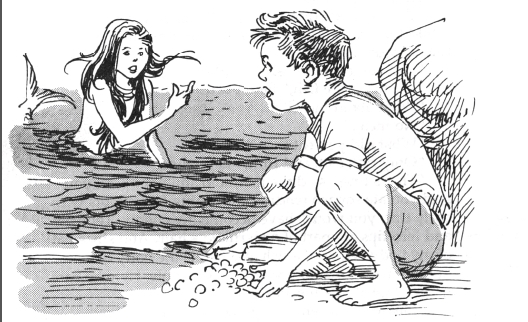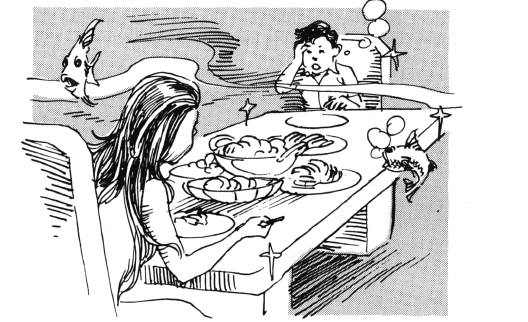THE WORD merfolk means ‘people of the sea’. There are numerous Philippine legends about merfolk, but their local names are few. It may be that the Spanish name— sirena—superseded most of the local names, which include:
kataw (‘one like us’) — West Visayan
litao — Ilokano
magindara—Bikol
mambubuno—Zambales
siukoy—Tagalog, Visayan
ugkoy—Tagalog, Visayan
As in European folklore, there are fewer mermen than mermaids in Philippine folklore. Mermaids are beautiful young women above the waist and fish below. Mermen are good-looking young men from head to waist and fish below that. Mermaids have long hair, a light complexion, and sweet voices, and mermen have short, curly hair and sunburnt skin. Both look like attractive youths above the waist, but their lower bodies are those of scaly fish. Since there are far fewer mermen than mermaids, it may be inferred that these creatures are polygamous but no legends to this effect are told.
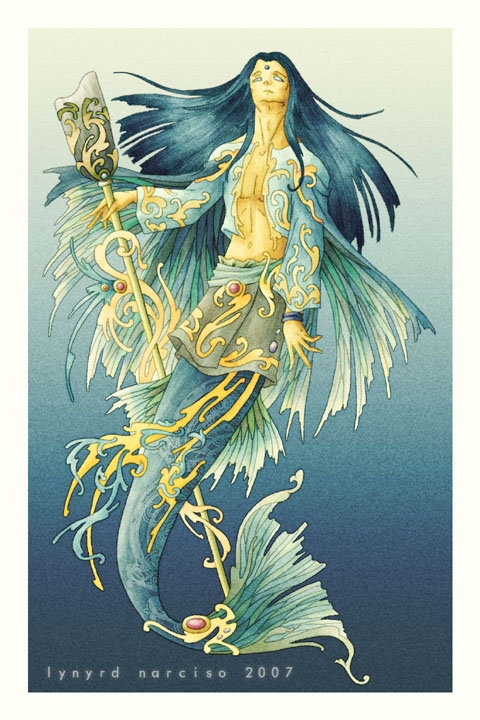
Unlike in Europe where merfolk inhabit salt water almost exclusively, Philippine mermaids and mermen abound in rivers, lakes, and the basins of waterfalls as well as bays, gulfs, and seas. A mermaid was often reported to have been heard wailing in distress—its method of attracting its prey—at night in a stream at the edge of this writer’s hometown during the rainy season. When the rains poured and the river leaped over a culvert across the stream, the farmers had to cross over from their outlying fields on foot at the end of the day, and their greatest fear was not that of drowning but of the mermaid they believed lying in wait for them in the water.
The basin of Botocan Falls, close to Manila, is reported to be inhabited by a mermaid although the falls has long been harnessed to generate electricity for the metropolis. The Pampanga River just north of Manila is also said to have mermaids lying in wait for unwary swimmers, and so are rivers throughout the country, from the Cagayan in the North of Luzon to the Maguindanao in the South.
Merfolk are said to have beautiful underwater homes with walls bright with gold and precious stones. They do not kill the children and youth they capture. They raise them in their underwater realm instead, and somehow their human captives do not drown. They marry them when they grow up. They entice children to get into the water with their enchanting voices. They sing sweet songs or plaintively lament to draw youngsters to them. When someone they like goes near, they make the water suddenly rise and grab him or her. They then take their captive to their underwater realm.

Merfolk are reported to march at the tail ends of religious processions and try to entice boys and girls to the river with them. This belief may have been invented to make children join religious processions promptly and avoid the tail ends of processions. Merfolk are also said to join crowds of people and whisper to their prospective victim: “Please walk me to the edge of the water.”
They are said to ask those they capture what they are fond of eating. When asked this question, one should avoid saying he is fond of meat or fish, otherwise the merman or mermaid will drown him or her for eating part of its body. Nor should one reply that he likes to eat greens with curly tips, for merfolk have curly hair.
Legends are told of many a river where a mermaid takes a child, known by the folk as a “tribute” to her. The victim is known as naserena (‘taken by a mermaid’), and the water where it happened is awakan in Southern Mindanao.
Described in Isabelo delos Reyes’ book, El Folk-lore Filipino, the litao is a male anito of the waters. In Vigan, it is a small man that lives in the branches of bamboo trees along river banks and is the husband of the sirena. The spirit sometimes goes on land disguised as a normal man and tends to the bamboo trees in his area. He curses with illness those that cuts the trees. In his human form his true nature is revealed through a strong fishy smell that emanates from his body.
A telltale trait of merfolk is their strong fishy smell.
The Visayan kataw is said to be a voluptuous maiden from head to waist, light-complexioned, and with wavy long hair. She has been seen singing on a rock out at sea and drying her long hair in the sun, and a dugong sunning itself on a rock at sea would closely resemble such a woman in silhouette. The mermaid entices fishermen who go near her, grabs them, and takes them to her underwater home and marries him if a man or raises him to manhood if a child and eventually weds him. By her magic power her human captive does not drown.
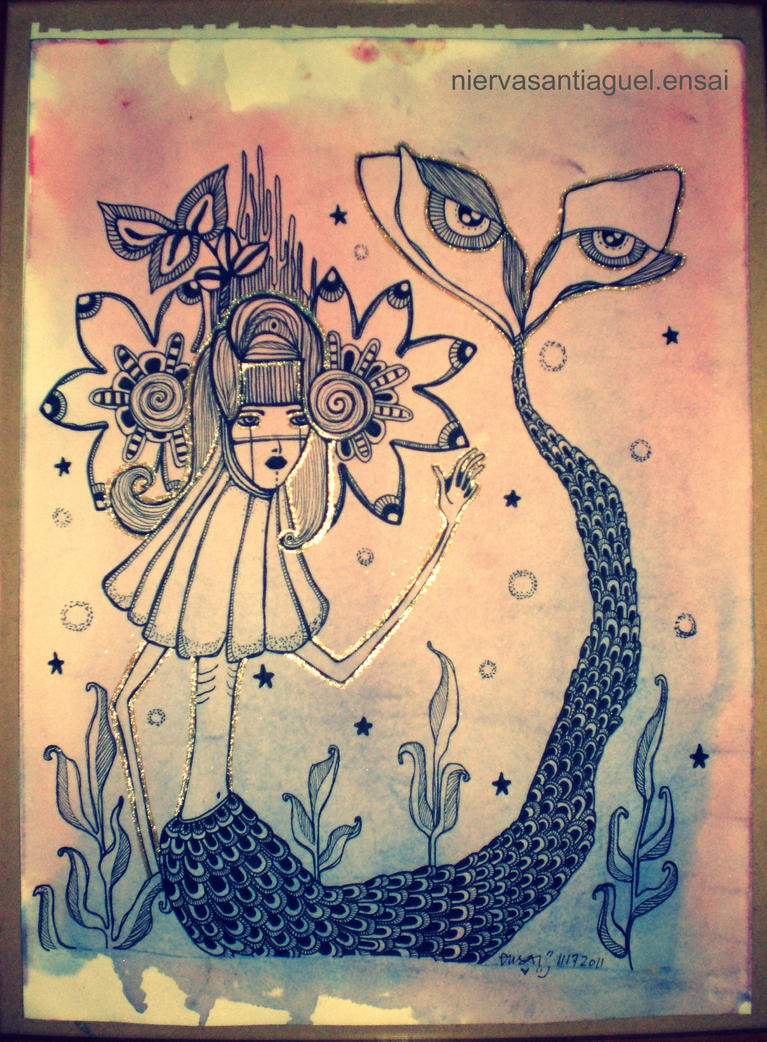
Like the other mermaids, the magindara of the Bikolanos is a beautiful maiden above the waist and a fish below. A young man went to live with a magindara in her cave under the sea and was never seen again.
The mambubuno, believed in by the Zambale, is said to have twin tails instead of a single tail. These are covered with dark, slimy fish scales in the males. Instead of being dark, the twin tails of the female mambubuno are said to be covered with scales of varied bright colors. The mambubuno may be found in a brook or river with a cave under its bank, and its home is bright with gold and precious stones. A mermaid marries the man she has enticed to go with her to her realm and keeps him as her prisoner without his knowing it. He may visit his folks if he promises to return. Should she catch him trying to escape, she will drown him and he will be found seated at the bottom of the water or squatting stiff there. If she lets him visit his folks, he will find them all aged or dead and the neighbors may not believe where he says he has been to all these years. That life with the mambubuno is blissful is indicated by the belief that a day with her seems a year in the world of men.
Sirena is the most common name of mermaids in the Philippines, a Spanish term which superseded many of the native names of the creature after the Spanish conquest.
It is said that one who has a birthmark on his eyeball is likely to see a sirena.
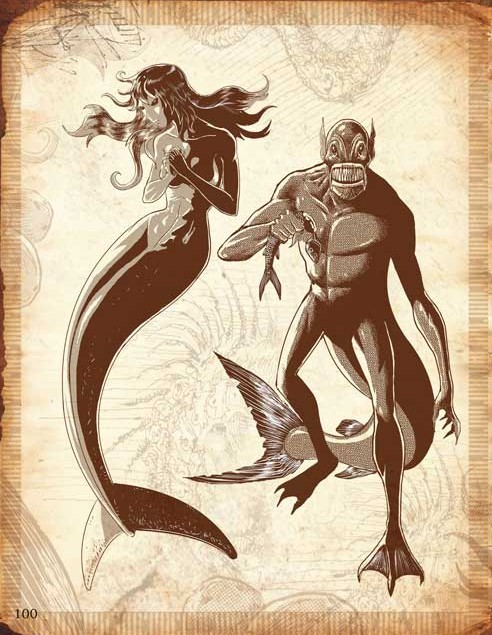
A mermaid’s hair is long and her voice is magically sweet. She makes children go to her by singing. At night a man may hear a sirena wailing in distress in the water and go down and try to help her. Then she will make the water suddenly rise and get him.
Visayans call the mermaid ugkoy and some Tagalogs call the merman siukoy. A siukoy’s skin is sunburned and hairy and his head hair copper-colored and wavy but relatively short.
Merfolk are said to frequent flooded rivers, floating quietly on the water to attract attention with their physical beauty. When they see youngsters swimming in the water, they pull them down by their legs and take them to their home.
The belief in merfolk has made Filipinos fear rivers and seas although their country consists of over 7,000 islands. And they commonly resort to dynamite fishing, one of the most harmful ways to catch fish, since dynamite kills fish fry as well as fishermen.
Homer is the author of the most famous story about sirens in literature. In the Odyssey, he tells of the enchantress Circe, who has charmed and held Odysseus and his men prisoners in her cave for many years but now lets them go, warns him that his ship will sail through a narrow strait inhabited by the sirens—beautiful sea nymphs with magically sweet voices. She tells Odysseus to stop his men’s ears with wax before they enter the strait and that if he wants to hear the sirens’ voices, he should leave his ears open but have himself tied to the mast and order his men to ignore his command to be released as they sail past the sirens. They get there and Odysseus’ men admire the beautiful sirens but do not hear their magic voices. Odysseus hears as well as sees them but his men ignore his orders to release him, and they all escape from the mermaids.
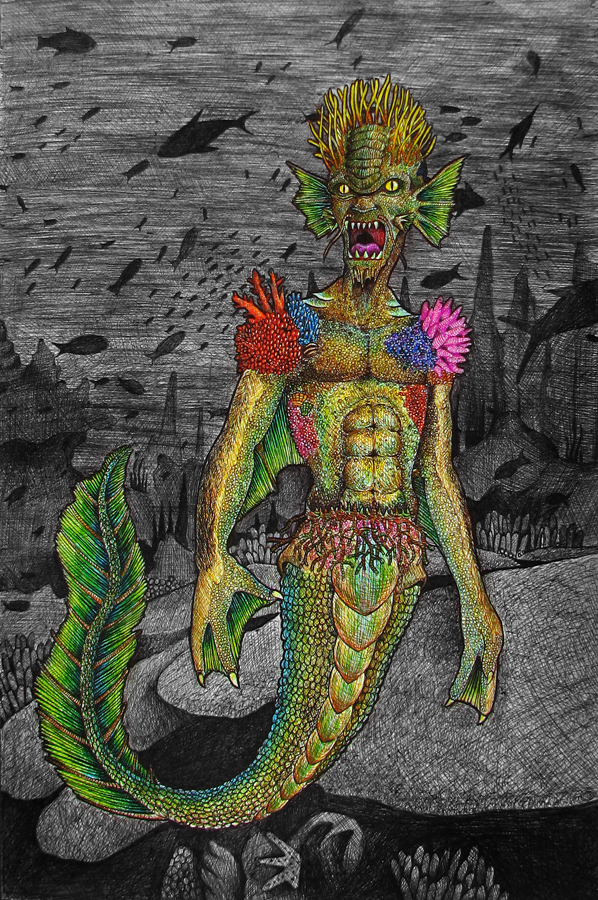
Heinrich Heine wrote a poem about a mermaid singing in the river Rhine—a rare case of siren in soft water in European literature.
Hans Christian Andersen, the Danish writer of fascinating fairy tales, tells a touching story of a mermaid that falls in love with a human sailor aboard his ship. She follows the ship wherever it sails but is never even noticed by him and her heart breaks and she dies. A bronze statue of her is shown seated on a rock by a river in Copenhagen. It was recently mutilated by a vandal but was promptly restored.
“The Forsaken Merman,” a poem by Matthew Arnold, tells a touching story of a village girl who went to live under the sea with a merman and they had children. Upon her insistence, he let her return to her home so that she may attend a church service. She is slow to return, and the merman and their children swim ashore and call out to her from outside the church walls, unable to enter. She does not hear them and never goes back to the sea, and that is Arnold’s spoof on traditional religion.
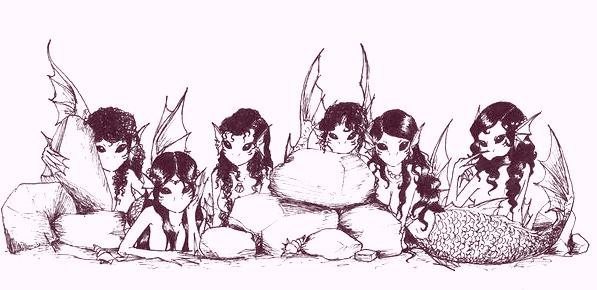
A mermaid legend used to be told by this writer’s mother, a descendant of immigrants from Paoay, Ilocos Norte, folk who pioneered in southern Zambales at the beginning of the nineteenth century. She evidently told it to warn her children to avoid going to the river that was within shouting distance from this writer’s gate. The legend went this way:
The Boy and the Mermaid
A little boy was gathering pebbles at the edge of the river one day when he saw a beautiful woman in the water. She smiled sweetly at him and said. “Come here, Son, and I will tell you a wonderful story.”
He was attracted by her sweet smile, her golden voice, and her long curls and walked to her. As soon as his feet touched the water, the river suddenly rose and he found himself in her arms.
“Let me go! Let me go!” screamed the boy.
She held him firmly and said, “Be quiet and I shall take you to a wonderful world you have never seen before.”
“My folks will be looking for me!” said the boy.
“A wonderful new world is waiting for you,” she said, diving into the water.
The boy saw that from the waist down her body was covered with fish scales, and it tapered into twin fins flipping from side to side as the two of them went through the water with little effort.
Soon they reached the sea, and the coral beds shone and painted fish flashed by as they swam through the clear water. At last they came to a beautiful house at the bottom of the sea. They entered a door and came into a gorgeous hall. The doors and windows had jambs of black coral, and the floors and furniture were gold accented with rubies and pearls.
They sat down, and the mermaid—for a mermaid she was—asked, “Tell me what greens you ate in the world of men. Did you eat boiled squash tops with long tendrils? Did you eat fern tips?”
“We never ate those things,” he replied, remembering it told that mermaids asked these questions to test those they captured.
“Did you eat fish?” she asked.
“We never ate fish,” he replied.
“What about meat?”
“No meat.”
“What did you eat then?”
“Only rice, salt, and fruit,” he replied.
“That’s fine,” said the mermaid smiling. “Had you said you ate squash tendrils and young fern shoots with curly tips, you would have become my enemy. Tendrils and fern tips are part of a mermaid’s hair. And since half of my body is that of a fish and half is the body of a human, I am a mix of both fish and people. He who eats fish and meat eats me and is my foe.”
“Please say when I can go home,” said the boy.
“This is your home now,” she replied. “Let me show you around,” she added, taking him by the hand, and they went around in the house. The first two rooms each contained a bed of gold with canopies studded with pearl. In the dining room were golden trays and porcelain ware.
The mermaid turned to the boy and said, ‘This is your home. Everything in it is yours.” Then she added: “I shall leave you awhile. Remember, this is your home. Enjoy it.”
She briefly disappeared into the back of the house and then returned and left through the front door.
The boy tried to enjoy himself but kept on thinking of his folks.
The mermaid returned at the end of the day with good things to eat. The boy pretended to enjoy the food and she offered him more of it, but he could eat little.
Then night came and she went to sleep in her golden bed. He, too, lay down in his bed in the next room but turned from side to side all night and had little sleep.
Before she left again next day, she stepped into the back of the house as she had done the day before and then left through the front door. “Enjoy yourself, eat lots of food, and grow quickly into a man,” she said, leaving him.
She promptly returned at the end of the day and they had a sumptuous meal and then went into their separate beds.
This went on day after day, and the boy kept longing for home.
He wondered why the mermaid went to the back of the house before she left each day. Was there a secret door she kept him from knowing about? He went to the rear of the house after she left to see if he could find a way of escape. He was feeling on the back wall one day when he felt a part of it give under pressure. He pushed harder and discovered a door so well hidden that he could not have distinguished it from the rest of the wall had he not pressed it. He was about to enter the door when he heard the mermaid turn the lock on the front door. He barely had time to shut the secret door quietly and go and meet her in the hall.
“Have you been enjoying yourself today?” she asked.
He nodded without a word.
“It’s dark at the back of the house,” she said. “Never go there.”
He nodded again, but as soon as she left next day, he rushed to the rear of the house and opened the secret door. He entered a little room and saw a porcelain jar standing on the floor. He looked into it and found a golden bowl floating there. It dawned on him that the mermaid bathed herself in the liquid before leaving for the world of men. He dipped the bowl and poured the liquid on his head and shoulders.
At once a trapdoor opened beneath his feet. He ran out, followed a sandy path into the world bright with sunshine and loud with the singing of birds. Soon he reached the river bank where the mermaid had captured him.
His folks and their neighbors were overjoyed when he got home and told them where he had been. They gave a big feast to celebrate his return.
For many nights after that, the villagers near the river heard a voice wailing plaintively at the stream. “That’s the mermaid,” the mothers told their children. “She is calling for her escaped prisoner.”
“Never play near the river again or the mermaid will get you,” added the grandmothers.
SOURCE: Philippine Demonological Legends and Their Cultural Bearings, Maximo Ramos, Phoenix Publishing 1990
ALSO READ: Sirena Stories, the Mythical Mermaid of the Philippines
Jordan Clark is a Canadian born descendant of Scottish immigrants living on the homelands of the Lekwungen speaking peoples. His interest in Philippine myth and folklore began in 2004. Finding it difficult to track down resources on the topic, he founded The Aswang Project in 2006. Shortly after, he embarked on a 5 year journey, along with producing partner Cheryl Anne del Rosario, to make the 2011 feature length documentary THE ASWANG PHENOMENON – an exploration of the aswang myth and its effects on Philippine society. In 2015 he directed “The Creatures of Philippine Mythology” web-series, which features 3 folkloric beings from the Philippines – the TIKBALANG, KAPRE and BAKUNAWA. Episodes are available to watch on YouTube. Jordan recently oversaw the editing for the English language release of Ferdinand Blumentritt’s DICCIONARIO MITOLÓGICO DE FILIPINAS (Dictionary of Philippine Mythology) and is working on two more releases with fellow creators scheduled for release later this year. When his nose isn’t in a book, he spends time with his amazing Filipina wife of 20 years and their smart and wonderful teenaged daughter.


